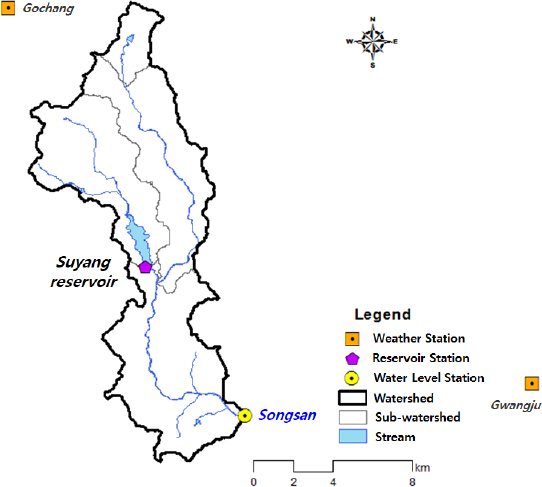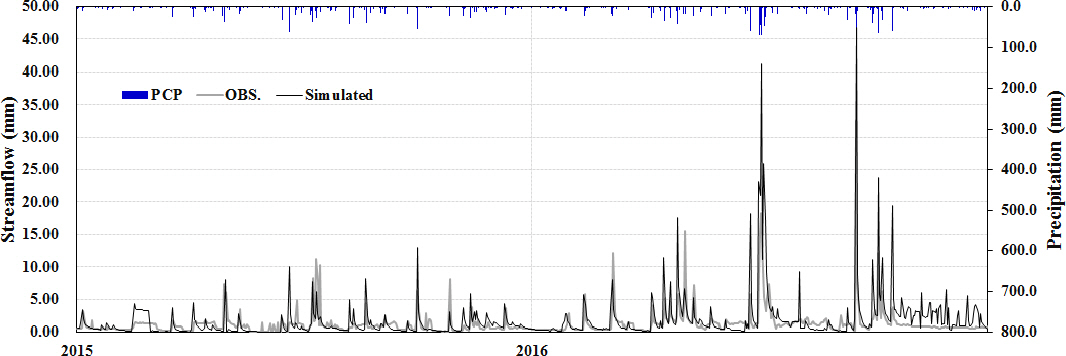1. Ahn, S.R, Lee, J.W, Jang, S.S, and Kim, S.J (2016) Large scale SWAT watershed modeling considering multi- purpose dams and multi-function weirs operation:For namhan river basin.
Journal of the Korean Society of Agricultural Engineers, Vol. 58, No. 4, pp. 21-35 (in Korean).

2. Arnold, J.G, Srinivasan, R, Muttiah, R.S, and Williams, J.R (1998) Large area hydrologic modeling and assessment part I:Model development.
Journal of American Water Resources Association, Vol. 34, No. 1, pp. 73-89.

3. Bang, J.H, Lee, S.H, Choi, J.Y, and Lee, S.H (2017) Evaluation of reservoir drought response capability considering precipitation of non-irrigation period using RCP scenario.
Journal of the Korean Society of Agricultural Engineers, Vol. 59, No. 1, pp. 31-43 (in Korean).

4. Cho, J, Hwang, S, Go, G, Kim, K.Y, and Kim, J (2015) Assessing the climate change impacts on agricultural reservoirs using the SWAT model and CMIP5 GCMs.
Journal of the Korean Society of Agricultural Engineers, Vol. 57, No. 5, pp. 1-12 (in Korean).

5. Hwang, S.H, Kang, M.S, Kim, J.H, Song, J.H, Jun, S.M, Lee, S.H, and Choi, J.Y (2012) Assessment of flood impact on downstream of reservoir group at hwangryong river watershed.
Journal of the Korean Society of Agricultural Engineers, Vol. 54, No. 3, pp. 103-111 (in Korean).

6. Kim, B.K, Kim, B.S, and Kwon, H.H (2009) Impact assessment of agricultural reservoir on streamflow simulation using semi-distributed hydrologic model. Journal of the Korean Society of Civil Engineers, KSCE, Vol. 29, No. 1B, pp. 11-22 (in Korean).
7. Kim, N.W, Chung, I.M, Won, Y.S, and Arnold, J.G (2008) Development and application of the integrated SWAT-MODFLOW model.
Journal of Hydrology, Vol. 356, pp. 1-16.

8. Lee, J, and Noh, J (2015) Evaluating water supply capacity of embankment raised reservoir on climate change.
Journal of the Korean Society of Agricultural Engineers, Vol. 57, No. 4, pp. 73-84 (in Korean).

9. Lee, J, Kim, N.W, Chung, I.M, and Lee, J.E (2015) Effects of irrigation reservoirs and groundwater withdrawals on streamflow for the anseongcheon upper watershed.
Journal of the Korean Society of Civil Engineers, Vol. 35, No. 4, pp. 835-844 (in Korean).

10. Lee, S.H, Yoo, S.H, Park, N.Y, and Choi, J.Y (2013) An analysis of environmental water release patterns considering operation rules in enlarged agricultural reservoirs.
Journal of the Korean Society of Agricultural Engineers, Vol. 55, No. 3, pp. 51-62 (in Korean).

11. Lee, T.H (2011). The study of water supply reliability considering the management for restricted water level of agricultural reservoirs during flood period. Master's thesis, Kookmin University, (in Korean).
12. Lee, Y.J, Park, M.J, Park, K.W, and Kim, S.J (2008) Analysis of hydrologic behavior including agricultural reservoir operation using SWAT model. Journal of the Korean Association of Geographic Information Studies, Vol. 11, No. 1, pp. 20-30 (in Korean).
13. Ministry of Agriculture, Food and Rural Affairs (MAFRA) (2011). Development of water quality index and management model for agricultural reservoir using artificial intelligence technique (I). MAFRA, Sejong, Korea: (in Korean).
14. Ministry of Agriculture, Food and Rural Affairs (MAFRA) (2016). A change of groundwater environment in accordance with enhancing embankment of the Su-yang reservoir. MAFRA, Sejong, Korea: (in Korean).
15. Mkhwanazi, M, Chavez, J.L, and Rambikur, E.H (2012) Comparison of large aperture scintillometer and satellitebased energy balance models in sensible heat flux and crop evapotranspiration determination. International Journal of Remote Sensing Applications, Vol. 12, pp. 24-30.
16. Nash, J.E, and Sutcliffe, J.V (1970) River flow forecasting through conceptual models:Part I. A discussion of principles.
Journal of Hydrology, Vol. 10, No. 3, pp. 282-290.

17. Neitsch, S.L, Arnold, J.G, Kiniry, J.R, and Williams, J.R (2001). Soil and water assessment tool;The theoretical documentation. p 340. p 367. U.S Agricultural Research Service, Temple, Texas.
18. Noh, J.K (2010) Affecting water supply capacity followed by allocating flood control volume in heightening reservoir. Journal of Korean National Committee on Irrigation and Drainage, Vol. 17, No. 2, pp. 57-70 (in Korean).
19. Oh, S.T, and Kim, J.T (2007) A time rivers outflow interpreting according to an agriculture reservoir operation. Proceedings of the Korea Water Resources Association Conference, pp. 174-177 (in Korean).
20. Park, M.J, Park, G.A, and Kim, S.J (2007) Analysis of hydrologic behavior of SLURP model including agricultural reservoir operation. Journal of the Korean Society of Civil Engineers, KSCE, Vol. 27, No. 5B, pp. 515-523 (in Korean).
21. Song, I.R, Jung, C.Y, Min, K.H, and Jung, S.W (2010) A study on runoff characteristics by a reservoir in hyungsan river basin. Proceedings of the Korea Water Resources Association Conference, pp. 1312-1316 (in Korean).













